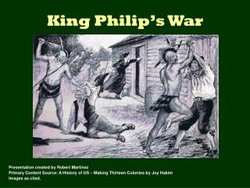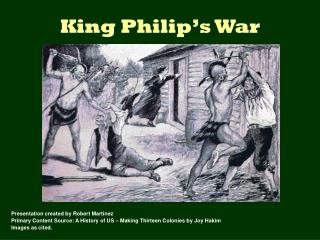Reprisal by colonists (non-contemporary depiction)
The few hundred colonists of Rhode Island became an island colony for a time as their capital at Providence was sacked and burned and the colonists were driven back to Newport and Portsmouth on Aquidneck Island. The Connecticut River towns with their thousands of acres of cultivated crop land, known as the bread basket of New England, had to manage their crops by limiting their crop lands and working in large armed groups for self-protection.[32]:20 Towns such as Springfield, Hatfield, Hadley and Northampton, Massachusetts, fortified their towns, reinforced their militias and held their ground, though attacked several times. The small towns of Northfield and Deerfield, Massachusetts, and several other small towns, were abandoned as the surviving settlers retreated to the larger towns. The towns of the Connecticut colony escaped largely unharmed in the war, although more than 100 Connecticut militia died in their support of the other colonies.
Reprisal by colonists (non-contemporary depiction)
The few hundred colonists of Rhode Island became an island colony for a time as their capital at Providence was sacked and burned and the colonists were driven back to Newport and Portsmouth on Aquidneck Island. The Connecticut River towns with their thousands of acres of cultivated crop land, known as the bread basket of New England, had to manage their crops by limiting their crop lands and working in large armed groups for self-protection.[32]:20 Towns such as Springfield, Hatfield, Hadley and Northampton, Massachusetts, fortified their towns, reinforced their militias and held their ground, though attacked several times. The small towns of Northfield and Deerfield, Massachusetts, and several other small towns, were abandoned as the surviving settlers retreated to the larger towns. The towns of the Connecticut colony escaped largely unharmed in the war, although more than 100 Connecticut militia died in their support of the other colonies.
Family Members
Advertisement
Explore more
Sponsored by Ancestry
Advertisement







